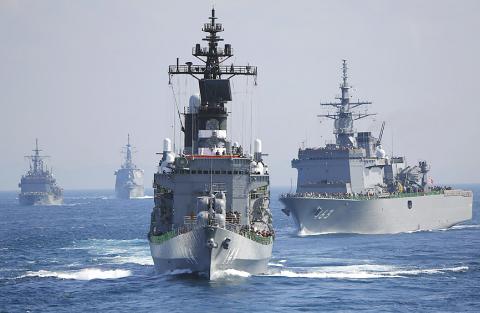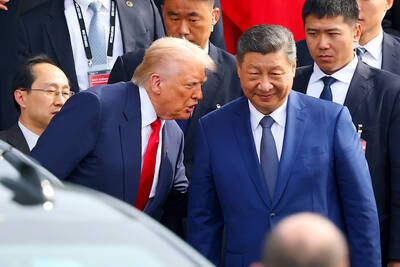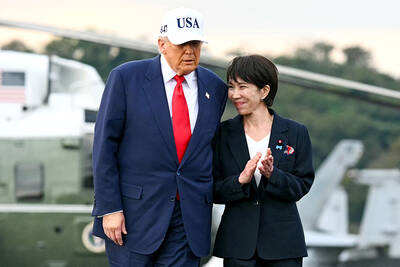The Japanese Cabinet yesterday approved a record-high military spending plan, endorsing plans to purchase pricey US surveillance drones and F-35 jets as Tokyo steps up cooperation with Washington amid China’s increasingly assertive activity in regional seas.
The ¥5.1 trillion (US$42.1 billion) proposal is part of a ¥96.7 trillion national budget for the fiscal year beginning in April, also an all-time high. The entire package requires Japanese parliamentary approval.
Military spending would rise 1.5 percent from this year, the fourth annual increase under Japanese Prime Minister Shinzo Abe, who ended a decade of defense budget cuts.

Photo: AP
The defense budget is the first since Japan enacted new security legislation in September enhancing the nation’s military role and since Japan revised its bilateral defense guidelines with the US earlier in the year to allow broader cooperation between the allies.
The new security law divided Japanese public opinion, with opponents saying it would increase a possibility of Japan being embroiled in a US-led war.
Japan is bolstering surveillance and defense of its southern islands, where it has a territorial dispute with China.
The budget also includes the purchase of an advanced Aegis radar-equipped destroyer with missile-defense capability, submarine construction and sonar development.
The Japanese Ministry of Defense plans to spend ¥14.8 billion this year on some of the multibillion-dollar, multi-year purchase of three “Global Hawk” unmanned drones, as well as six F-35 jets for ¥138 billion and a Boeing mid-air refueling aircraft KC-46A at ¥23 billion.
“We believe the budget includes items that would contribute to enhancing Japan-US cooperation in the area of ISR,” Japanese Ministry of Defense official Tomoki Matsuo said, referring to information, surveillance and reconnaissance.
Japan pays ¥193 billion for about 50,000 US troops stationed in Japan under their bilateral security treaty, more than half of them on Okinawa — a major source of friction between the central government and the southern island, which is frustrated with the decades-long burden.
The cost to move some of them to Guam and a contentious plan to move the US Marine air base from the crowded Futenma area to a less-populated location on Okinawa was also added to the budget.

CALL FOR SUPPORT: President William Lai called on lawmakers across party lines to ensure the livelihood of Taiwanese and that national security is protected President William Lai (賴清德) yesterday called for bipartisan support for Taiwan’s investment in self-defense capabilities at the christening and launch of two coast guard vessels at CSBC Corp, Taiwan’s (台灣國際造船) shipyard in Kaohsiung. The Taipei (台北) is the fourth and final ship of the Chiayi-class offshore patrol vessels, and the Siraya (西拉雅) is the Coast Guard Administration’s (CGA) first-ever ocean patrol vessel, the government said. The Taipei is the fourth and final ship of the Chiayi-class offshore patrol vessels with a displacement of about 4,000 tonnes, Lai said. This ship class was ordered as a result of former president Tsai Ing-wen’s (蔡英文) 2018

UKRAINE, NVIDIA: The US leader said the subject of Russia’s war had come up ‘very strongly,’ while Jenson Huang was hoping that the conversation was good Chinese President Xi Jinping (習近平) and US President Donald Trump had differing takes following their meeting in Busan, South Korea, yesterday. Xi said that the two sides should complete follow-up work as soon as possible to deliver tangible results that would provide “peace of mind” to China, the US and the rest of the world, while Trump hailed the “great success” of the talks. The two discussed trade, including a deal to reduce tariffs slapped on China for its role in the fentanyl trade, as well as cooperation in ending the war in Ukraine, among other issues, but they did not mention

Japanese Prime Minister Sanae Takaichi yesterday lavished US President Donald Trump with praise and vows of a “golden age” of ties on his visit to Tokyo, before inking a deal with Washington aimed at securing critical minerals. Takaichi — Japan’s first female prime minister — pulled out all the stops for Trump in her opening test on the international stage and even announced that she would nominate him for a Nobel Peace Prize, the White House said. Trump has become increasingly focused on the Nobel since his return to power in January and claims to have ended several conflicts around the world,

GLOBAL PROJECT: Underseas cables ‘are the nervous system of democratic connectivity,’ which is under stress, Member of the European Parliament Rihards Kols said The government yesterday launched an initiative to promote global cooperation on improved security of undersea cables, following reported disruptions of such cables near Taiwan and around the world. The Management Initiative on International Undersea Cables aims to “bring together stakeholders, align standards, promote best practices and turn shared concerns into beneficial cooperation,” Minister of Foreign Affairs Lin Chia-lung (林佳龍) said at a seminar in Taipei. The project would be known as “RISK,” an acronym for risk mitigation, information sharing, systemic reform and knowledge building, he said at the seminar, titled “Taiwan-Europe Subsea Cable Security Cooperation Forum.” Taiwan sits at a vital junction on